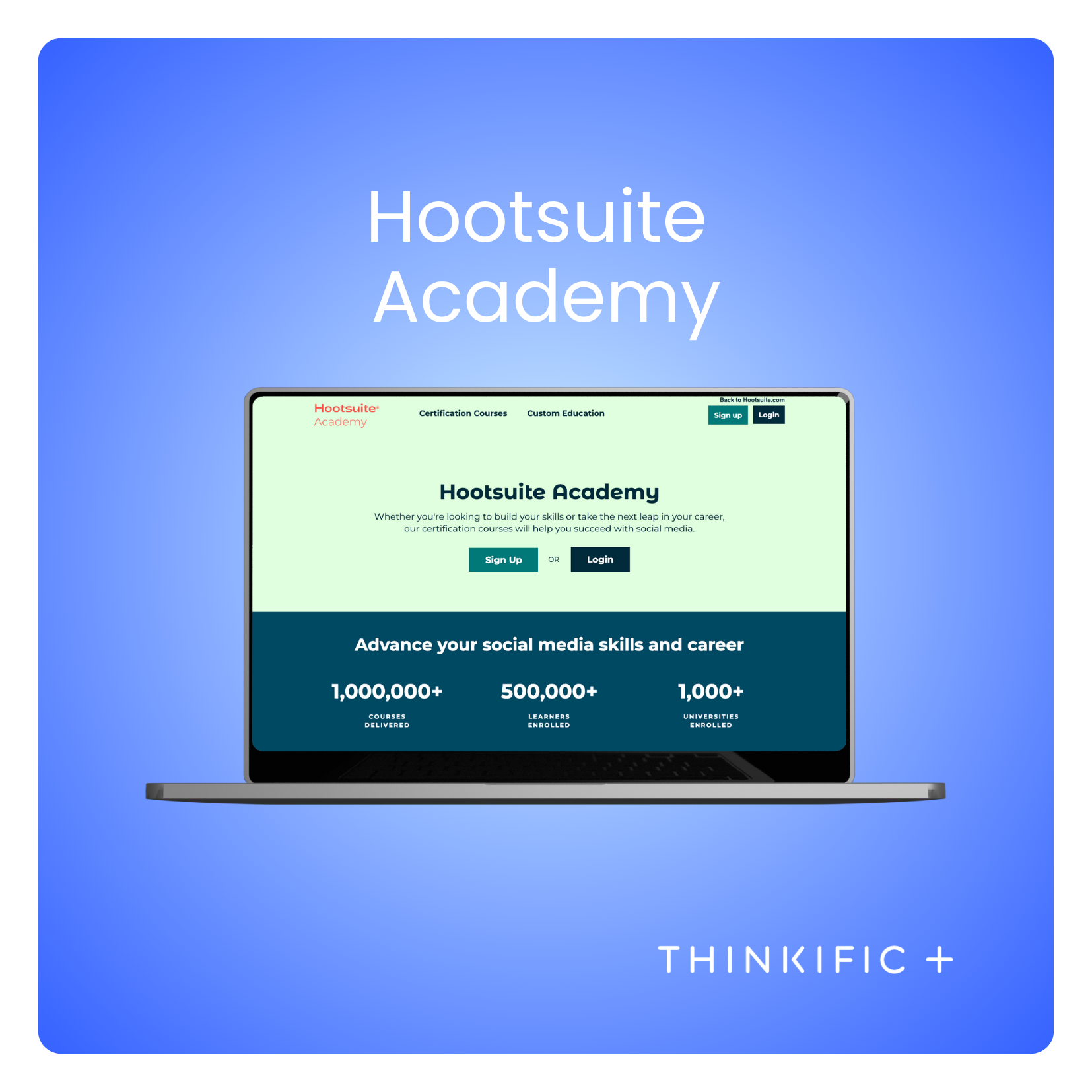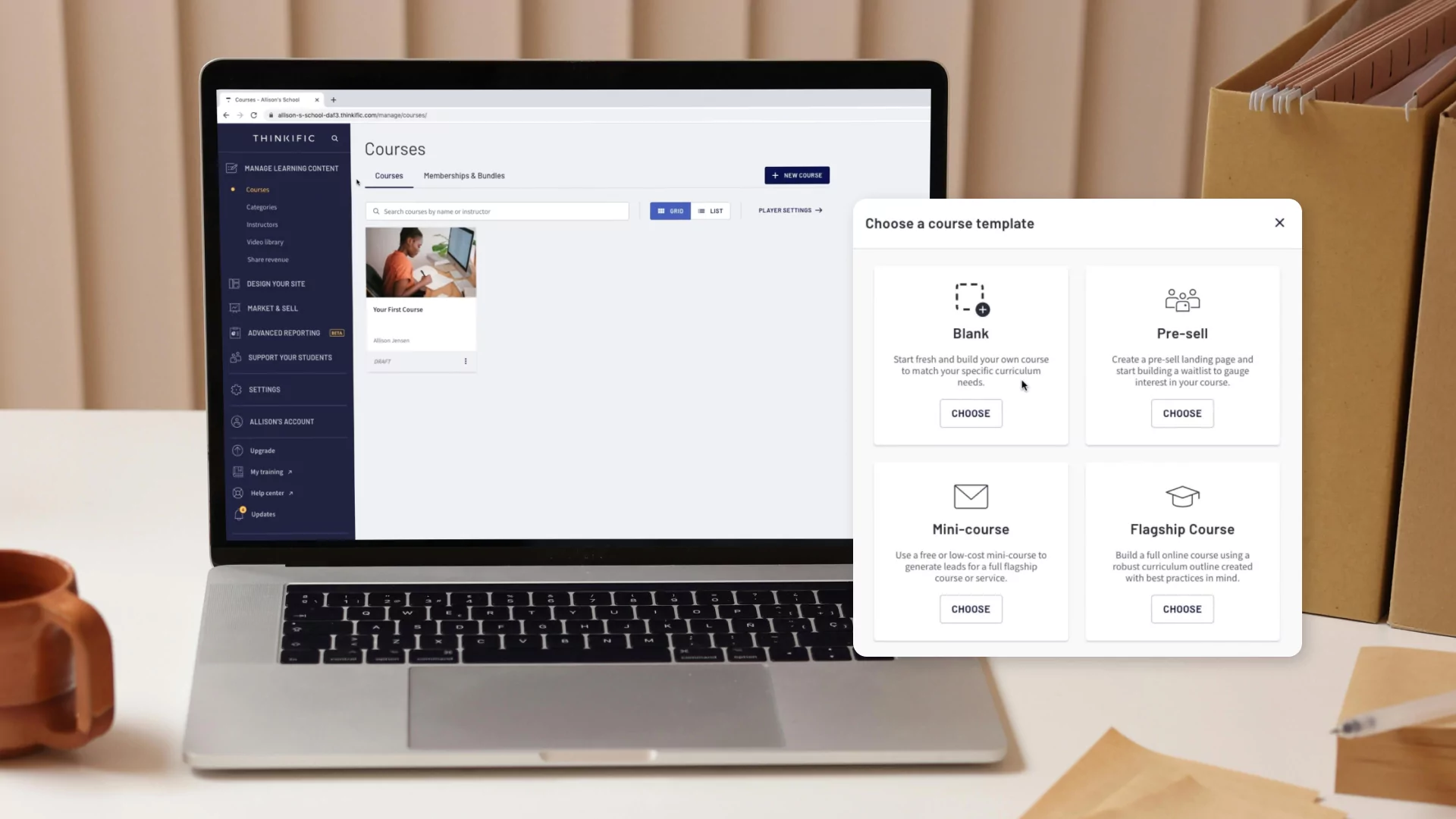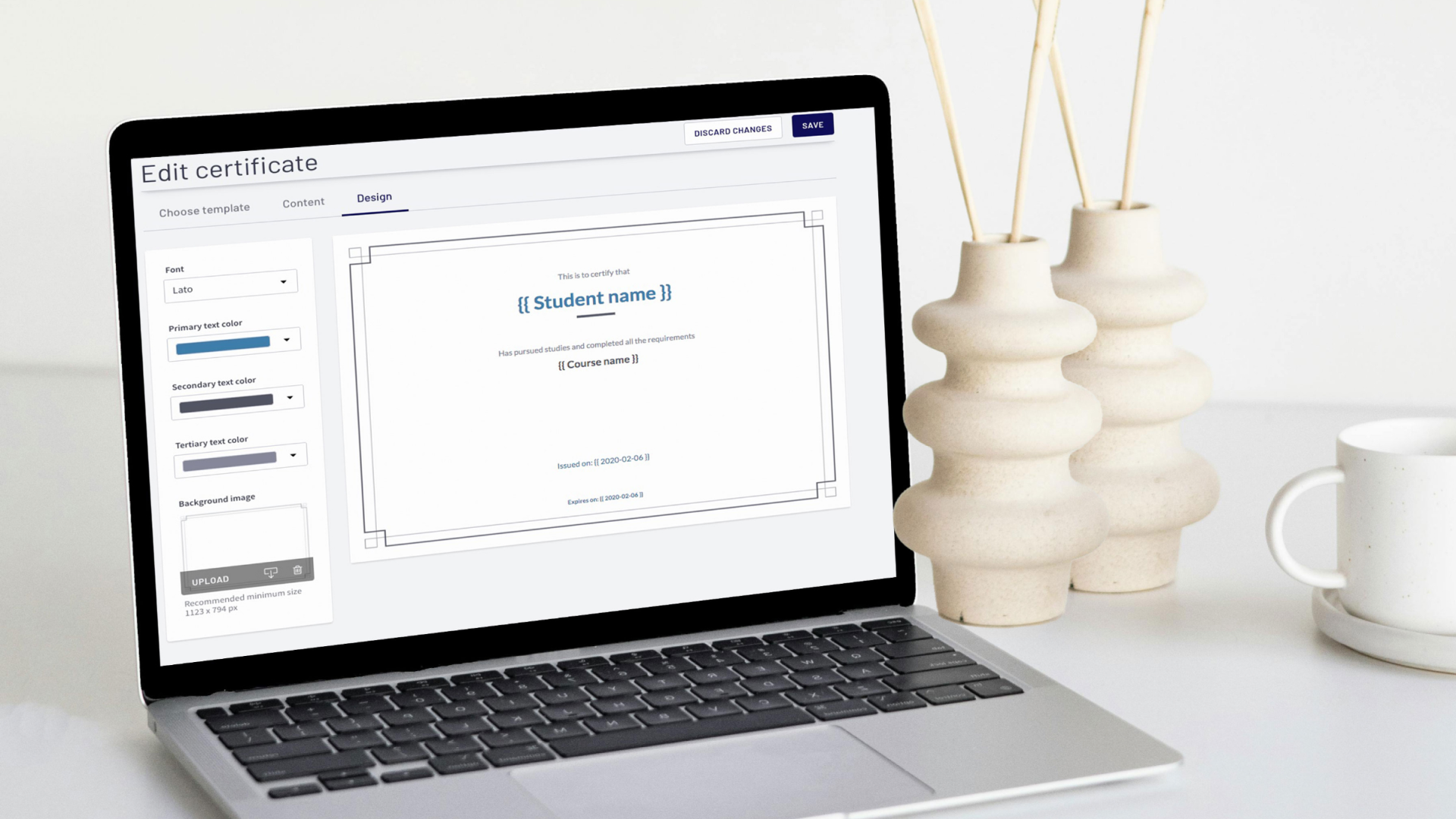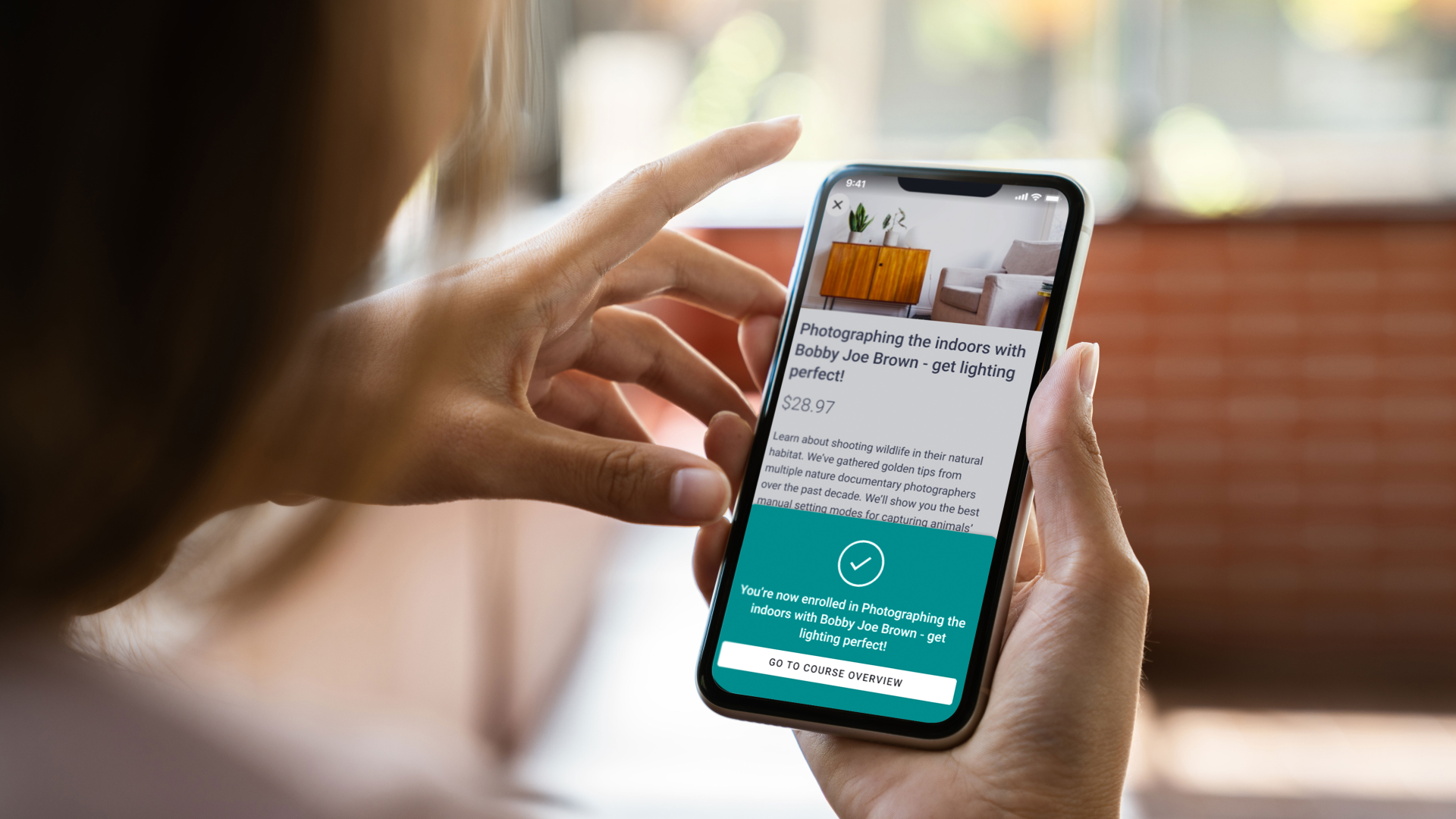Choosing the right customer training software is about more than just ticking off a list of features—it’s about finding a platform that empowers your team to drive meaningful business growth and ensure customer success at every stage. The right software doesn’t just support learning; it transforms your ability to onboard new customers, streamline support efforts, and boost overall retention—all while delivering measurable results.
In today’s fast-paced business landscape, impactful learning experiences are critical to keeping customers engaged and satisfied. A well-chosen platform can help you scale your training programs effortlessly and build stronger, more loyal customer relationships.
In this blog, we’ll examine the top features to consider when selecting customer training software.
Keep reading to explore how platforms like Thinkific Plus can help accelerate business outcomes and meet the evolving needs of enterprise-level organizations.
Skip ahead:
- What Does Customer Training Software Do?
- Key Benefits of Customer Training Software for Enterprise Companies
- Increased Customer Retention
- Efficient Customer Support
- Better Customer Onboarding
- Higher Annual Recurring Revenue
- 8 Essential Features of Customer Training Software for Effective Learning
- Enterprise-Specific Customer Training Software Features
- Conclusion
What Does Customer Training Software Do?
Customer training software is a vital tool for businesses to create, deliver, and manage educational content that empowers their customers. These platforms go beyond simple tutorials, providing a structured, interactive learning experience that supports customers at every stage of their journey—from onboarding to product adoption and retention.
Using videos, webinars, and interactive content, customer training software helps ensure that users can quickly understand and get the most out of your product. Platforms like Thinkific Plus make it easy to create dynamic, engaging learning environments that boost customer engagement, drive product adoption, and ensure long-term success.
Key Benefits of Customer Training Software for Enterprise Companies
Customer training software delivers significant benefits that directly impact your company’s bottom line. By streamlining the onboarding process, these platforms enable customers to realize value faster, which in turn drives higher product adoption and reduces time to value.
A better user experience leads to happier, more engaged customers—ultimately slashing churn rates and increasing customer lifetime value (CLTV). With customer training software, your business can also scale customer education efforts efficiently, cutting support costs while delivering personalized, on-demand learning experiences tailored to various needs.
Effective customer education improves customer retention by building customer loyalty, promoting upsell and cross-sell opportunities, and fostering a community of empowered users who become advocates for your brand.
Increased Customer Retention
Customer retention is crucial for keeping customer acquisition costs (CAC) low and driving long-term business success. By providing ongoing training, personalized support, and fostering strong relationships, businesses can significantly reduce churn and enhance customer loyalty.
Customer training software allows you to build scalable education programs that keep your customers engaged and informed about new features and best practices. These programs improve the overall product experience, helping your customers get more value from your offerings and deepening their connection with your brand.
Here are a few ways customer success teams can leverage customer training software to boost retention and engagement:
- Provide continuous education: Offering ongoing training and resources that keep customers up to date on the latest features and best practices.
- Collect and act on feedback: Systematically gathering customer feedback through the training platform and using it to improve product features or services.
- Build a user community: Creating a space where customers can connect, share ideas, ask questions, and support each other, fostering a sense of belonging and loyalty.
Efficient Customer Support
Customer training platforms enable businesses to scale their customer success efforts efficiently by offering self-paced, interactive learning experiences. Rather than relying on one-on-one support, customers can access crucial information at their own pace whenever needed. This enhances the customer experience and reduces the demand on support teams, saving time and resources.
By encouraging customer self-sufficiency through scalable training programs, businesses can significantly reduce support costs while ensuring that customers still receive the education and assistance they need. Choosing a platform that allows your team to edit and update your content easily is essential, ensuring that it remains accurate, relevant, and helpful as your product evolves.
Seamless Customer Onboarding
Customer education plays a critical role in reducing Time-to-Value (TTV)—the time it takes for customers to realize the benefits of your product. By offering targeted educational content during onboarding, your team can accelerate the customer journey and set new customers up for success right from the start.
Engaging tutorials and interactive walkthroughs help customers quickly master vital features, enabling them to complete tasks they may have struggled with before. These early successes not only build confidence but also demonstrate immediate product value.
While total ROI may take time, these quick wins drive revenue retention, deepen engagement, and create momentum for lasting customer satisfaction and loyalty.
Consider PayShepherd as an example, a company that transformed its customer onboarding process using a customer training platform. By implementing an online education program, PayShepherd reduced their onboarding time by an impressive 75%, accelerating customer time-to-value and creating significant time savings for their team. Their streamlined onboarding approach improved feature adoption and enabled their customers to quickly gain value from the product, setting the stage for long-term success. Learn more: PayShepherd Saves 350 Hours in 3 Months by Scaling Customer Training with Thinkific Plus Learn more: PayShepherd Saves 350 Hours in 3 Months by Scaling Customer Training with Thinkific Plus |
Maximize Annual Recurring Revenue
A well-designed customer education program doesn’t just support product adoption and retention; it can also be a powerful tool for increasing Annual Recurring Revenue (ARR). Customer Success (CS) teams can encourage upsells and expand existing accounts by offering personalized educational experiences—such as tailored product demos or customized client packages—based on individual customer needs.
Customer Training Platforms enable businesses to offer these scalable, personalized learning experiences. By providing data-driven insights into product usage and customer behavior, CS teams can proactively identify opportunities for upselling and cross-selling.
Customer Success teams can leverage these insights to demonstrate how customers can get more out of their product by adopting underutilized features or suggesting complementary services that align with their goals. This adds value to the customer experience, strengthens customer loyalty, and drives higher revenue growth.

For example, Hootsuite’s certification courses clearly illustrate how customer education can lead to increased ARR. By offering specialized courses and certifications, Hootsuite not only helps users master its social media management tools but also provides an added value that customers are willing to pay for. These certification programs help Hootsuite deepen customer engagement and create new revenue streams, as businesses are more likely to invest in their team’s ongoing education. This increases feature adoption and encourages customers to stay subscribed to the platform and invest in additional courses over time, boosting retention and ARR.
By implementing similar educational offerings, companies can provide tangible value to their customers while generating incremental revenue through training and certifications.
Learn more: How Hootsuite Educates Customers and Generates Revenue Using Thinkific Plus
8 Essential Features of Customer Training Software for Effective Learning
Choosing the right Customer Training Software is essential to delivering an impactful customer education experience. The features you select should meet your business needs and enhance how your users engage with and access content.
Platforms like Thinkific Plus offer a range of features that make it easier for businesses to create, manage, and scale their customer education programs.
Here are eight key features to look for in a customer training platform:
1. Dynamic Content Creation Tools
A dynamic course should offer an intuitive interface, multimedia support, and interactive elements to help you create engaging and professional courses without needing extensive technical skills.
Platforms like Thinkific Plus provide drag-and-drop functionality, diverse media integration (including videos, quizzes, and interactive elements), and AI-powered tools that streamline content creation. These features make building dynamic, high-quality courses easy to keep learners engaged from the start.
2. Quick Creation of Websites and Easy Learning Experiences
The ability to easily and quickly add to a professional learning environment is critical to delivering seamless customer education. Look for platforms that offer drag-and-drop functionality, multimedia support, and user-friendly design tools for your team members.
Customer training software will ideally make setting up a polished and engaging learning experience easy, ensuring you can launch courses without extensive technical knowledge. Look for platforms with functionality incorporating quizzes, video content, and downloadable resources. This will ensure that you can cater to different learning styles and ensure a smooth, easy-to-navigate user experience.
3. Certifications and Digital Badges
Certifications and digital badges are powerful tools that can significantly boost customer engagement and retention. These gamification elements provide tangible value by motivating learners to complete courses and proudly showcase their accomplishments, all while reinforcing the practical relevance of your educational content.
From industry leaders like Hootsuite to popular platforms like Mentimeter, businesses everywhere are leveraging certifications and badges to keep learners engaged and invested. By offering custom certificate designs, automated issuance, and seamless verification portals, you can create a motivating, results-driven learning environment that benefits both your customers and your business.
For enterprise companies, certifications are more than just acknowledgments—they are valuable credentials that foster professional growth and drive product adoption.
Here’s what to look for when implementing certifications and digital badges in your customer education program:
- Custom certificate design: Ensure your platform allows you to create fully branded certificates that align with your corporate identity, providing a professional and personalized touch.
- Automated issuance: Set course completion criteria and let your training platform automatically issue certificates when learners meet those requirements.
|
By incorporating certifications and digital badges, your team can create an engaging learning experience that drives long-term customer success while strengthening brand loyalty.
4. Built-in Community and Discussions
Learning is far more effective in a connected, collaborative environment. When selecting customer training software, look for platforms that offer built-in community features, such as discussion forums, live chat, and spaces for user-generated content.
Fostering peer-to-peer learning and creating a community around your educational content can accelerate the learning process and keep your users engaged long-term. Community features like course-specific discussion zones, real-time interactions, and spaces for learners to share insights promote deeper collaboration and help your customers feel more connected to your brand.

Here are some key community features to look for:
- Discussion forums: Set up course-specific or general discussion areas where learners can ask questions, engage in Q&A sessions, and provide peer support.
- User-generated content: Allow learners to share their insights, experiences, and knowledge, enriching the learning ecosystem and making it more dynamic.
Integrating these community-driven tools allows you to transform your customer education program into a thriving, interactive space that encourages ongoing engagement, learning, and retention.
5. Easily Accessible Resource Libraries, aka “Customer Education Academy”
A centralized resource library or “Customer Education Academy” is crucial for providing your customers with quick, easy access to all the learning materials they need. With customer training software, you can create an organized, user-friendly resource hub that stores everything from documents and guides to videos and online courses.
By offering easily accessible digital resources, your learners will always have up-to-date information at their fingertips, reducing confusion and minimizing support requests. A well-structured resource library ensures that your customers can quickly find exactly what they need when they need it—empowering them to navigate your product independently and effectively.

Key benefits of a Customer Education Academy:
- Centralized access: Store all learning materials in one place in structured learning paths, making it easy for customers to find and access resources without hassle.
- Up-to-date information: Ensure customers have the latest, most accurate content and knowledge to reduce confusion and enhance their learning experience.
- User-friendly navigation: Organize your resources by topic, role, or product feature to help customers quickly locate the specific information they need.
With a robust, accessible resource library, your customers can continue their learning journey on their own terms, increasing engagement and self-sufficiency while reducing the demand on your support team.
6. Customized Learning Paths
Creating personalized learning experiences is key to boosting engagement, satisfaction, and learning outcomes. With the right customer training software, your team can design custom learning journeys tailored to specific user roles, skills, or assessment results, ensuring each customer gets the most relevant and impactful content.
Platforms like Thinkific Plus offer powerful learning path features that allow you to:
- Set prerequisites: Ensure customers complete foundational courses before advancing to more complex content, providing a logical learning progression.
- Create adaptive learning paths: Tailor the learning experience based on customer preferences, delivering content that matches their specific needs and expertise.
- Deliver personalized content: Customize each learner’s journey to ensure they receive training that aligns with their unique goals and abilities.
By implementing customized learning paths, you can guide users through a structured, personalized education process that keeps them engaged and helps them achieve their objectives—ultimately driving product adoption and customer success.
| Hootsuite chose Thinkific Plus to set up their online academy because they needed to be able to educate thousands of students at once and upload a range of rich multimedia content like videos. With an ever-evolving SaaS product, Hootsuite also wanted the ability to update course content and make changes quickly and easily. Using Thinkific Plus’s student feedback features, the team was also able to glean insight into how students were progressing and enjoying the content, feeding back valuable suggestions on how to improve the experience. |
7. Mobile-Friendly Learning
In today’s mobile-first world, offering mobile-friendly learning options is crucial for engagement and course completion. Your customer training sotware must provide responsive design and even white-labelled mobile apps with offline access, allowing learners to engage with content anytime, anywhere.
This flexibility boosts engagement and ensures that users can continue their learning journey on the go, making it easier for them to fit education into their busy schedules.
8. Robust Reporting and Analytics
In the enterprise world, gut feelings won’t cut it. Your customer education software should offer a panoramic view of your program’s performance, as data-driven insights are essential for optimizing customer education. Look for platforms that provide robust reporting and analytics to track learner progress, course completion rates, and overall engagement.
Platforms like Thinkific Plus, with features like advanced analytics, enable you to make data-informed decisions to improve your content and maximize ROI. With integrations to business intelligence tools, you can also dive deeper into analytics to effectively refine and scale your customer education efforts.
“We wanted something that would allow us and our clients to track what our students were doing, what they were watching, and how many people were watching them. We really wanted to get good analytics and have everything under one roof, which is Thinkific Plus.” – Erin O’Donnell, Co-Founder and Managing Director of Education and Events Technology at BankersHub.
Enterprise-specific Customer Training Software Features
Customer training software can benefit businesses of any size, but enterprise-level organizations require more sophisticated and scalable solutions to meet their complex needs.
Enterprise customer training software typically requires advanced features specifically designed to handle the demands of large-scale operations, diverse user groups, and intricate product ecosystems. These enterprise-focused features ensure seamless integration with existing systems, robust analytics, and enhanced security to protect sensitive data.
Let’s explore some key features that set enterprise-level customer training platforms apart:
Single Sign-On (SSO)
Imagine your IT team saving up to half their help desk time by fixing the seemingly minor issue of password reset. It’s estimated that 30% to 50% of IT help desk calls are for password resets, a complex task costing businesses valuable time. It’s not just an IT problem; it’s a productivity killer across your organization, making a simple login process critical.
In the enterprise world, security and ease of access go hand in hand. SSO capabilities will give you:
- Simplified login processes: Users can access your learning platform using their existing corporate credentials.
- Enhanced security: Reduce the risk of credential-based attacks by centralizing authentication.
- Streamlined user management: Automatically activate and deactivate users based on your corporate directory.
Digital Downloads
By offering downloadable content, your team can engage new audiences, generate leads, and create additional income sources with minimal effort. Digital downloads allow you to repurpose existing content or develop new materials in various formats, including eBooks, guides, templates, audio files, and more. This is a powerful way to diversify your content offerings and boost revenue streams.
This strategy seamlessly introduces customers to your brand and sparks interest in your other products or services. Promoting these digital products with user-friendly marketing tools and optimized landing pages is a breeze, even for marketing newcomers. Whether offered on their own or as added value alongside other services, digital downloads present an exciting opportunity to maximize content value and efficiently broaden your business’s reach.
Unlimited Admins
A standout feature in enterprise customer training software is unlimited admin access, a game-changer for large organizations with complex structures. This allows you to scale your programs effortlessly, allowing team members from different departments to manage training content without incurring additional licensing costs.
Imagine the possibilities for enterprises: subject matter experts, content creators, and customer success managers collaborating to maintain an ever-evolving library of educational resources. As your program evolves, so does your team—and your customer education platform should evolve with you, offering features like:
- Role-based access control: Assign specific permissions to different team members.
- Audit logs: Keep track of who’s making changes to your courses and when.
- Collaborative tools: Enable team members to collaborate on creating and managing courses.
E-commerce Capabilities
Transform your enterprise customer training with advanced e-commerce software, turning educational content into a lucrative revenue stream. With multi-currency support, expand your reach globally and tap into international markets. The right training platform allows you to monetize your expertise with high-quality training options to boost revenue and strengthen customer relationships.
Your customer training software should offer flexible pricing options like one-time purchases, subscriptions, and bundled packages tailored to diverse customer needs.
Look for e-commerce features such as:
- Flexible pricing models: Offer one-time purchases, subscriptions, or bundled packages.
- Multi-currency support: Sell globally with support for various currencies.
- Affiliate program management: Turn your best customers into advocates with built-in affiliate tools.
SCORM Compliance
Compatibility with a sharable content object reference model (SCORM) is a must for customer training software. SCORM is a widely recognized standard in online education. With SCORM support, users can easily import content from various third-party authoring tools, making it simple to integrate existing materials.

Moreover, SCORM compatibility allows for complex assessment methods, including screen recordings and simulation-based quizzes, offering a more comprehensive evaluation of learner progress. By sticking to SCORM standards, customer education software should ensure content integrity and help achieve measurable learning outcomes.
B2B Grouping and Management
Group management features enable course creators to segment students, facilitate bulk course sales, and generate custom reports tailored to specific cohorts or organizations. With Groups, you can automate student enrollment based on customizable filters, offer private courses with special pricing to client organizations, and track progress across different teams or job roles.
The feature lets you do cohort analysis for better marketing strategies and create time-sensitive promotions with unique invite links. Your LMS software should offer enterprise-level functionality that helps you scale your business by streamlining B2B sales processes and improving client management.
Open API and Graph QL
A robust application programming interface (API) is key to making this integration work, allowing the platform to connect easily with various essential business tools. This connectivity lets you customize integrations with CRMs, marketing automation tools, and other essential systems, ensuring data syncs smoothly and enabling advanced workflow automation.
Customer training platforms have innovated their integration capabilities. Your customer education platform should offer cutting-edge API experience using GraphQL technology, with an API-first approach that gives unmatched access to internal tools and data.
This boost ramps up performance for big operations and offers more customization options, from managing communities to tracking learner progress in detail. By tapping into these advanced API features, you can craft personalized learning experiences that fit your specific needs and vision, all while streamlining processes and boosting efficiency.
Conclusion
When choosing the right customer training software for your business, it’s essential to focus on platforms that offer scalability, robust features, and seamless integration. Platforms like Thinkific Plus provide the tools to create impactful and engaging learning experiences, from dynamic course creation to mobile-friendly content and advanced analytics. These features enhance customer onboarding and retention and open up new revenue streams through education.
For enterprise-level businesses, additional features such as Single Sign-On (SSO), group management, and e-commerce capabilities help streamline operations and scale customer education efficiently. Choosing a platform supporting your goals can drive deeper engagement, reduce churn, and create long-lasting customer relationships.
If you’re looking to enhance your customer education program, consider exploring platforms like Thinkific Plus that offer the flexibility and power needed to meet the demands of today’s enterprise businesses.
Thinkific Plus: Your Enterprise-Ready Customer Training Software
Thinkific Plus is your go-to for enterprise-level customer training, ticking all the boxes for impactful education. With tools for creating dynamic content, customizable learning paths, mobile learning, advanced reporting, and seamless integration with your business systems, it covers all the bases for delivering a captivating training experience. Plus, with SCORM compatibility, unlimited admins, and robust e-commerce capabilities, you can scale up your customer education and achieve real outcomes.
Frequently Asked Questions (FAQ)
- How can customer training software help reduce support costs?
Customer training software cuts down support costs by providing self-paced, on-demand learning, reducing the need for one-on-one help. Customers can discover answers and explore product features on their own, giving your support team a break. - Is customer training software customizable for different industries or products
Customer training software is customizable and can be adapted for different industries or products. It includes features like learning paths, multimedia content, and certification options, which help businesses create tailored training programs to fit their needs. - How can customer training software improve product adoption?
Customer training software enhances product adoption by providing structured, on-demand educational content that helps users quickly and easily understand how to use key features. By offering interactive quizzes and learning paths, these platforms ensure customers gain confidence in using the product, leading to faster feature adoption. With accessible and well-organized training materials, learners can fully leverage your product’s features, resulting in higher ROI and overall satisfaction.










